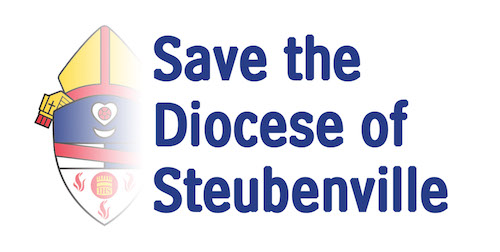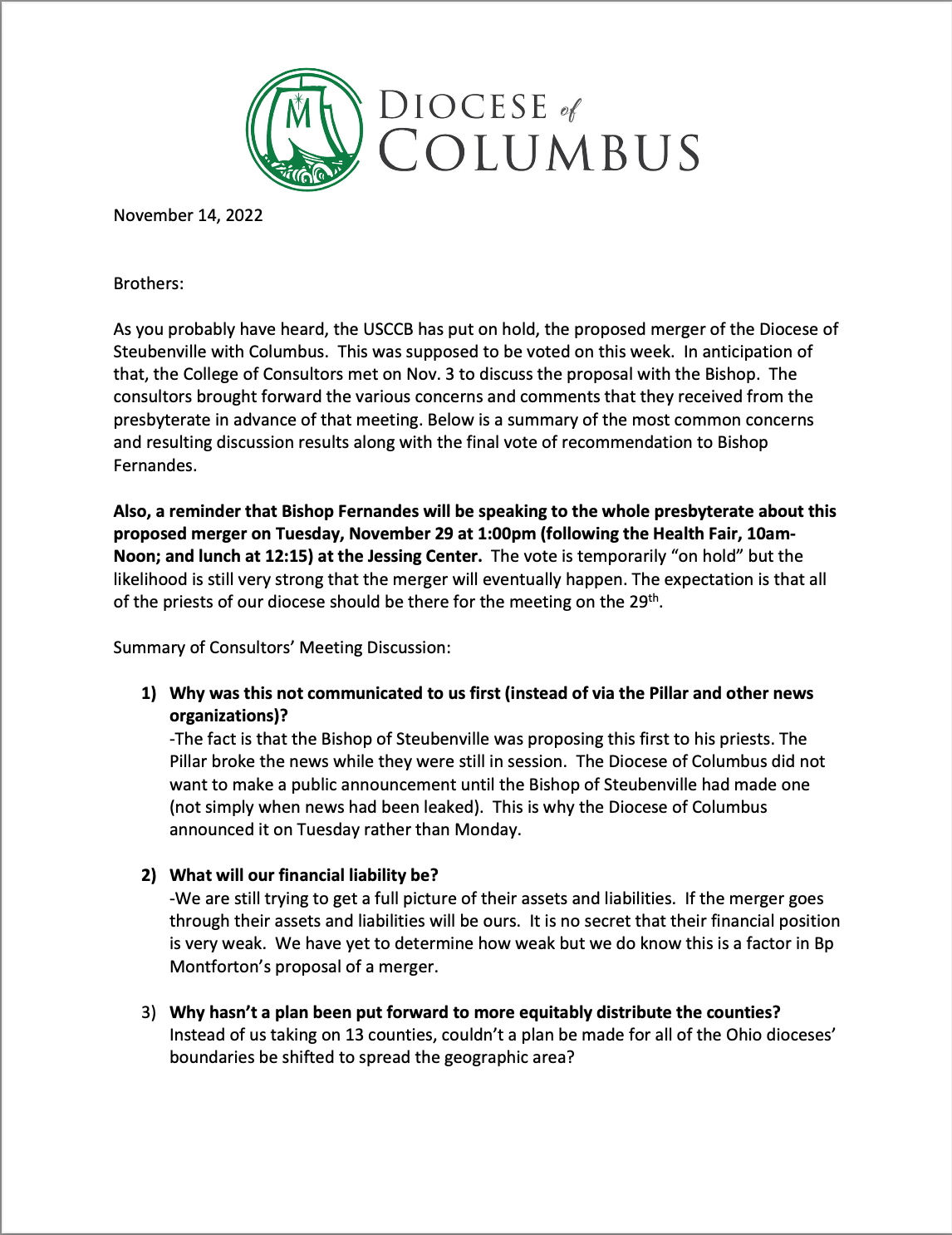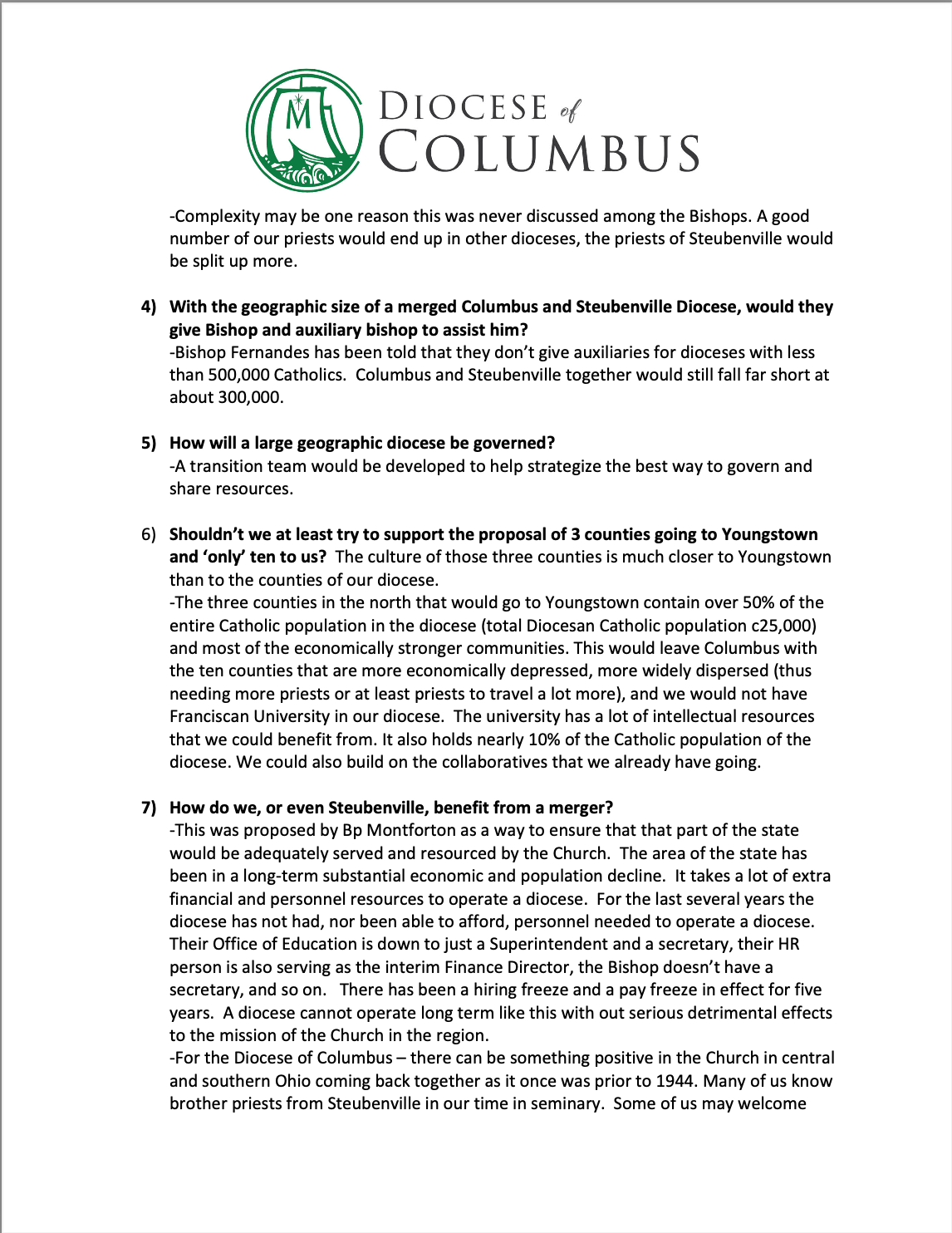On November 3 the College of Consultors of the Diocese of Columbus met with Most Rev. Earl Fernandes, bishop of Columbus, to discuss the potential merger of the Diocese of Steubenville with the Diocese of Columbus. A couple of votes were taken and a number of questions were discussed.
Subsequently, the Vicar for Clergy of the Diocese of Columbus, Father Bill Hahn, wrote a letter to the whole presbyterate of the Diocese of Columbus with information from that discussion. I have here printed the whole text of that letter. Screen grabs of the pdf of the letter are below.
Wrong “Facts” About Finances
First and foremost, some of the “facts” presented in this letter are not facts at all. In the letter, the financial situation of the Diocese of Steubenville is presented as “very weak.” The evidence provided to support this is a few paragraphs later:
For the last several years the diocese has not had, nor been able to afford, personnel needed to operate a diocese. Their Office of Education is down to just a Superintendent and a secretary, their HR person is also serving as the interim Finance Director, the Bishop doesn’t have a secretary, and so on. There has been a hiring freeze and a pay freeze in effect for five years.
Five rather important points about this litany:
- The bishop does have a secretary. She works very hard at her job.
- The HR person is serving as the interim Finance Director because the last full-time finance director resigned this past summer and Bishop Monforton has not replaced her. The reason is not because of a lack of money.
- Staff have received “cost of living” increases in pay. It’s not much as raises go, but it does mean pay hasn’t been frozen.
- The hiring and pay “freeze” over the past five years are at least as much because of the financial scandal and the pandemic as anything else. The financial scandal is resolved, the pandemic is more or less in the past. Now is the time to rebuild trust and reignite the faith in this region, not to throw in the towel.
- The Diocesan Finance Council insists that the Diocese is in good financial shape. Indeed, even in his statements about the merger, Bishop Monforton has said that the Diocese is “solvent.” Independent and transparent confirmation of the financial situation would be nice, but Bishop Monforton holds sole authority to release the actual financial numbers, and he so far hasn’t decided to do so. So we must trust either what the Bishop says or what the Finance Council says. With all due respect to His Excellency, I tend to believe the Finance Council.
Population and Jobs Again
Beyond the weak financial situation, the letter also cites the shrinking population and the poor jobs market as reasons that the merger is a certainty, if delayed.
But of course, the population and jobs situation in the Diocese is not as bleak as Bishop Monforton and this letter claim.
Why Not Youngstown?
The other real revelation in this letter is the reason why Jefferson, Carroll, and Belmont counties wouldn’t be merged into Youngstown, with the other ten counties going to Columbus. This is another rather infuriating revelation, and another example of Bishop Monforton not being square with us. Meantime the Columbus College of Consultors is looking out for itself first, and the needs of Steubenville’s Catholics second.
First, Bishop Monforton’s lack of transparency: Back on October 26, His Excellency said that the idea of merging these three counties with Youngstown “was discussed but seemed more advantageous to be merged with Columbus, especially with the location of the priests in the Steubenville Diocese.”
This was in a Q&A published in The Steubenville Register.
In that post I wrote in response:
Advantageous how? Youngstown is closer, and has more in common, culturally and historically, with Steubenville than does Columbus. Also, since the majority of the Catholics in the Diocese of Steubenville are in the northern three counties — those closest to Youngstown — wouldn’t there be more priests in these counties? So then again, wouldn’t that suggest Youngstown would be a better fit, at least for these three counties?
Now we know. Advantageous to the Diocese of Columbus. The added burden to the Catholics of Jefferson, Belmont, and Carroll counties is secondary.
The College of Consultors’ letter explains this. They point out that more than 50 percent of the Catholics in the Diocese live in these three northern counties, that these counties have the majority of the wealth of the Diocese, and, of course Franciscan University of Steubenville is here.
The College of Consultors of Columbus, in union with their bishop, basically say “if we’re going to be forced to take those ten counties, then we must also get the three choice counties.”
But even if we step past that rather glaring problem, this is still an odd argument for them to make for two reasons I can think of.
First, FUS would be happy to work with Bishop Fernandes and priests of Columbus regardless of diocesan lines. They don’t need FUS within the Diocese to benefit from it.
Second, if the argument is that Steubenville must be suppressed due to weak finances, then it isn’t like the “wealth” of the better-off three counties has helped the other ten counties much up to this point. Why, then, would a change to Columbus change that? Seems that all 13 counties would then just be a drag on the 26 counties presently in the Diocese of Columbus.
What About Bob?
The last bit I’ll note about this letter before presenting the text and screen grabs is the way it talks about the priests of Steubenville. To my knowledge, none of the members of the College of Consultors of Columbus has sought input or feedback from the clergy of the Diocese of Steubenville. And yet, in the letter they muse on Steubenville priests desiring opportunities to work in suburban parishes the likes of which you do not find in this Diocese.
On the contrary, a fair number of the priests of Steubenville could have discerned to become priests for other dioceses — like Columbus — but they opted for Steubenville. I’ve heard that among Steubenville priests, hardly any — if any at all — who are under 50 years old are happy about this merger. Those Steubenville priests who support it, or who are ambivalent, will all be retired within the next ten or 15 years anyhow and so won’t have to live with the ramifications for the next 40 years.
We’re like the elderly man in that one scene from Monty Python and the Holy Grail. We really feel fine and we’d like to just go for a walk, if you’d kindly refrain from clubbing us to death and tossing us on the cart.
(And now the featured image makes sense.)
Voting Just to Vote
The letter ends with the results of two votes: one to accept the “lesser” ten counties and let the “better” three counties go to Youngstown, the other to insist on getting all 13 counties if the merger were a done deal. As can be expected, both votes were unanimous to reject getting just the lesser ten, and to insist on getting all 13.
So all that said, here is the screen grab and text of the letter.
The Letter’s Pages
Full Text of the Letter
Brothers:
As you probably have heard, the USCCB has put on hold, the proposed merger of the Diocese of Steubenville with Columbus. This was supposed to be voted on this week. In anticipation of that, the College of Consultors met on Nov. 3 to discuss the proposal with the Bishop. The consultors brought forward the various concerns and comments that they received from the presbyterate in advance of that meeting. Below is a summary of the most common concerns and resulting discussion results along with the final vote of recommendation to Bishop Fernandes.
Also, a reminder that Bishop Fernandes will be speaking to the whole presbyterate about this proposed merger on Tuesday, November 29 at 1:00pm (following the Health Fair, 10am‐ Noon; and lunch at 12:15) at the Jessing Center. The vote is temporarily “on hold” but the likelihood is still very strong that the merger will eventually happen. The expectation is that all of the priests of our diocese should be there for the meeting on the 29th.
Summary of Consultors’ Meeting Discussion:
- Why was this not communicated to us first (instead of via the Pillar and other news organizations)?
‐The fact is that the Bishop of Steubenville was proposing this first to his priests. The Pillar broke the news while they were still in session. The Diocese of Columbus did not want to make a public announcement until the Bishop of Steubenville had made one (not simply when news had been leaked). This is why the Diocese of Columbus announced it on Tuesday rather than Monday. - What will our financial liability be?
‐We are still trying to get a full picture of their assets and liabilities. If the merger goes through their assets and liabilities will be ours. It is no secret that their financial position is very weak. We have yet to determine how weak but we do know this is a factor in Bp Montforton’s proposal of a merger. - Why hasn’t a plan been put forward to more equitably distribute the counties?
Instead of us taking on 13 counties, couldn’t a plan be made for all of the Ohio dioceses’ boundaries be shifted to spread the geographic area?
-Complexity may be one reason this was never discussed among the Bishops. A good number of our priests would end up in other dioceses, the priests of Steubenville would be split up more. - With the geographic size of a merged Columbus and Steubenville Diocese, would they give Bishop and auxiliary bishop to assist him?
‐Bishop Fernandes has been told that they don’t give auxiliaries for dioceses with less than 500,000 Catholics. Columbus and Steubenville together would still fall far short at about 300,000. - How will a large geographic diocese be governed?
‐A transition team would be developed to help strategize the best way to govern and share resources. - Shouldn’t we at least try to support the proposal of 3 counties going to Youngstown and ‘only’ ten to us? The culture of those three counties is much closer to Youngstown than to the counties of our diocese.
‐The three counties in the north that would go to Youngstown contain over 50% of the entire Catholic population in the diocese (total Diocesan Catholic population c25,000) and most of the economically stronger communities. This would leave Columbus with the ten counties that are more economically depressed, more widely dispersed (thus needing more priests or at least priests to travel a lot more), and we would not have Franciscan University in our diocese. The university has a lot of intellectual resources that we could benefit from. It also holds nearly 10% of the Catholic population of the diocese. We could also build on the collaboratives that we already have going. - How do we, or even Steubenville, benefit from a merger?
‐This was proposed by Bp Montforton as a way to ensure that that part of the state would be adequately served and resourced by the Church. The area of the state has been in a long‐term substantial economic and population decline. It takes a lot of extra financial and personnel resources to operate a diocese. For the last several years the diocese has not had, nor been able to afford, personnel needed to operate a diocese. Their Office of Education is down to just a Superintendent and a secretary, their HR person is also serving as the interim Finance Director, the Bishop doesn’t have a secretary, and so on. There has been a hiring freeze and a pay freeze in effect for five years. A diocese cannot operate long term like this with out serious detrimental effects to the mission of the Church in the region.
‐For the Diocese of Columbus – there can be something positive in the Church in central and southern Ohio coming back together as it once was prior to 1944. Many of us know brother priests from Steubenville in our time in seminary. Some of us may welcome more options in rural Appalachian parishes; some of them may welcome opportunities to minister in suburban and urban areas not presently available in the Diocese of Steubenville. We already have some great relationships with Franciscan University that we can build on. - Could it simply be a case of mismanagement? The scandals, some bad decisions, ‐ couldn’t new leadership turn it around?
‐If it were a case of one problem here or there, but this is economic and demographic forces beyond the diocesan scope that are driving the problem. There is a widening chasm between the desire to resource mission in this area and the ability to do so. - Is there a way to avoid this or if not at least delay this?
‐It seems unlikely to be avoided for the above reasons. [We subsequently know the answer to the second half of the question]
At the conclusion of the meeting two votes were taken by Bishop Fernandes.
The results:
To recommend to the Bishop to vote for the acceptance of ten counties with the three northern going to Youngstown?
‐For 0
‐Against 7
To recommend to the Bishop to vote for the acceptance of all thirteen counties?
‐For 7
‐Against 0
See you on November 29th!
Fr. Bill Hahn
Vicar for Clergy




